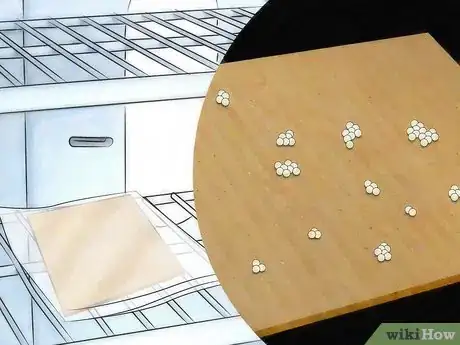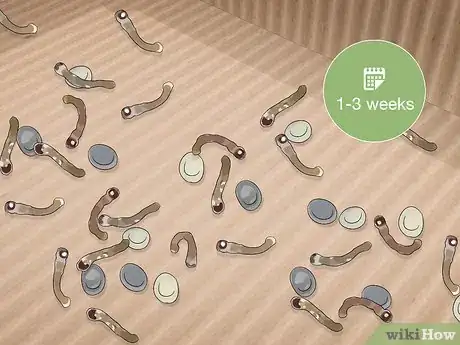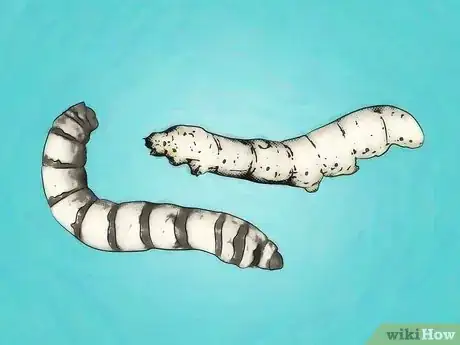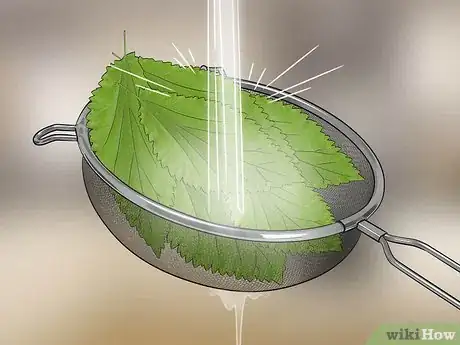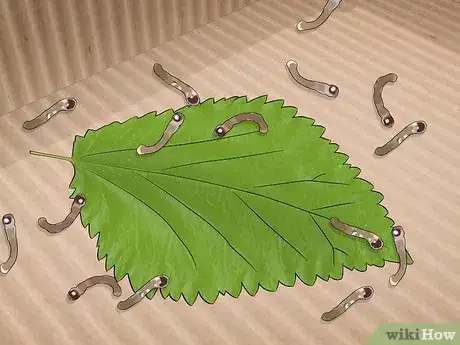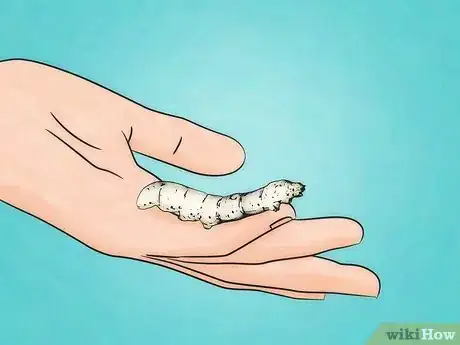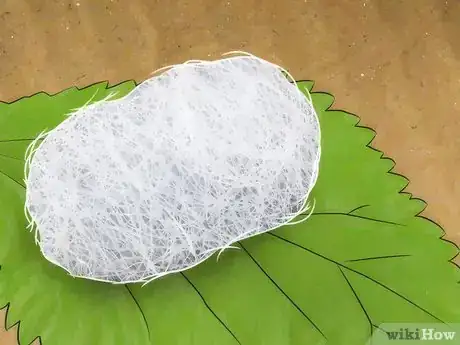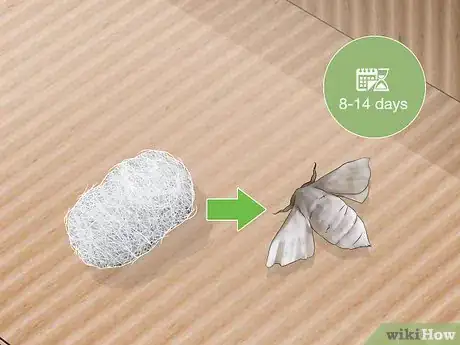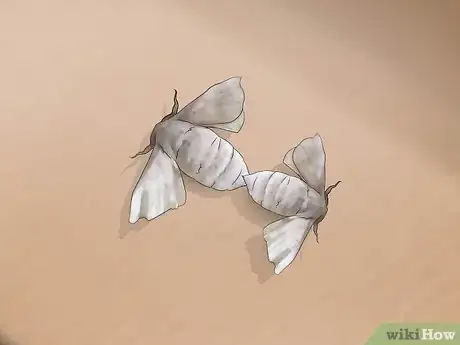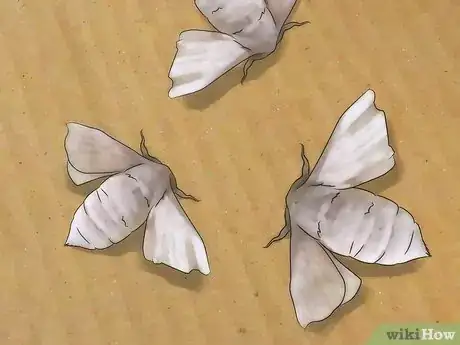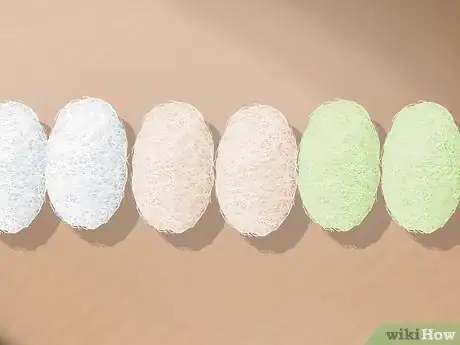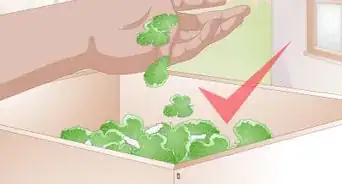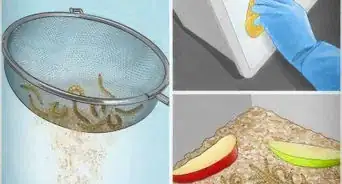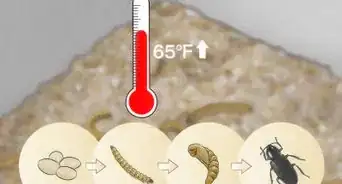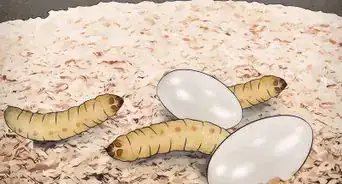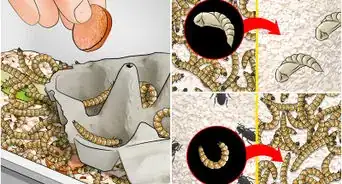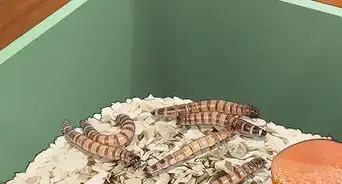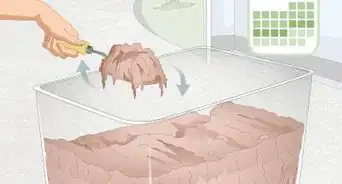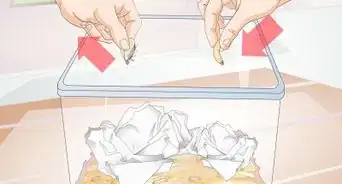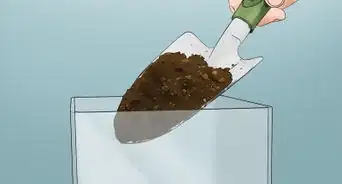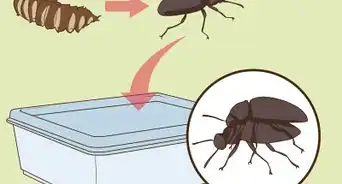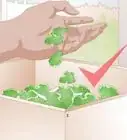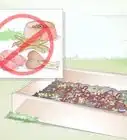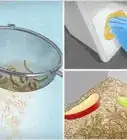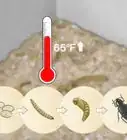This article was co-authored by wikiHow Staff. Our trained team of editors and researchers validate articles for accuracy and comprehensiveness. wikiHow's Content Management Team carefully monitors the work from our editorial staff to ensure that each article is backed by trusted research and meets our high quality standards.
There are 9 references cited in this article, which can be found at the bottom of the page.
This article has been viewed 50,666 times.
Learn more...
When we think of domesticated animals, most of us picture farm animals, or maybe horses and camels. But every silk scarf you've ever seen was made by a domesticated animal too: the tiny silkworm. Humans have been breeding these insects for silk for over 7,000 years.[1] At this point, the silkworms are so used to it that just about anyone with a warm room can look after them. This is an especially fun project for children, or anyone who wants the chance to care for an underappreciated kind of animal.
Steps
How long do silkworm eggs take to hatch?
-
1About one to three weeks depending on temperature. If the temperature is perfect (about 29ºC / 84ºF), the eggs can hatch in as little as nine days.[9] At room temperature, your eggs might take up to three weeks.[10]
- It's normal for some eggs to fail to hatch. Blue eggs that fail to hatch might be a sign that the eggs weren't handled right, so try ordering from a different supplier next time.[11] (But some blue eggs can still hatch, so don't give up them.)
-
2Eggs can also keep overwinter in a warm fridge. Many silkworms only reproduce once a year, and their eggs do best when they stay dormant until the next spring. If you successfully breed the silkworms, it's usually best to keep the new generation of eggs in the refrigerator until next spring. Keep the fridge temperature above 10ºC (50ºF) to avoid killing the eggs.[12]
- This temperature is higher than the standard food-safe fridge temperature, so use a separate mini-fridge
- If your silk worm breed was labeled "bivoltine," "polyvoltine," or with a number 100 or above, you could try to breed multiple generations per year, between spring and fall. Even then, the breeding schedule isn't guaranteed, since it's affected by heat and light.[13]
How do you feed silkworm larvae?
-
1Mulberry leaves are best, but not available year-round. You'll need two types of leaves. Thin, tender, young mulberry leaves are the only ones the youngest silkworms can eat. Thick, juicy, dark green leaves are better for older larvae.[20]
- If you can't get the young leaves, use artificial food and switch to mature leaves later.
- Ask the people who sell the leaves whether good-quality leaves will be in season until at least 24 days after the eggs hatch.[21] If not, it's better to use artificial food the whole time instead. Silkworms fed on mulberry leaves sometimes won't accept artificial food later.[22]
-
2You can order artificial food online instead. This should come with instructions that tell you how to prepare it before feeding your silkworms, and how much they eat. Food is the only way that silkworms get water, so make sure to replace it as soon as it dries out.[23]
-
3Wash the mulberry leaves before feeding. Leaves can carry diseases or pests. Wash them under running water, then shake dry and store them in the fridge in plastic bags.[24] (A little damp is fine, but silkworms don't want soggy leaves.) Before each feeding, throw away any yellow or dried up leaves.[25]
- It's even better to go the extra mile and disinfect them.[26] To do this, add 3 tablespoons (44 mL) of bleach and a drop of dishwashing detergent to 1 gallon (3.8 L) of water. Soak the leaves for three minutes, then rinse them very thoroughly under running water. (Any soap left can kill the larvae.) Shake dry and store in plastic bags in the fridge.
-
4Start with one leaf a day, then increase as they grow. Wrap the stem of a mulberry leaf in a scrap of moist paper towel and put it in the container. Replace this at least once a day. After a few days, start putting in several leaves bunched together instead.[27] Use enough leaves (or replace them often enough) that the silkworms always have access to fresh food.
- For the first couple days, use a soft paintbrush to very gently pick up the tiny, newly hatched larvae and move them off of the old leaf, then onto the new one.[28]
- If the newly hatched larvae aren't eating, the leaves might be too thick. Try slicing them as thinly as you can and sprinkling them into the container, or switch to artificial food.[29]
How do you get the silkworms to cocoon?
-
1Put in sections of toilet paper roll when the larvae turn translucent. Silkworm larvae usually molt four times, then spend a final six or seven days feeding before they're ready to make a cocoon. Their bodies then turn a little translucent, and they stop eating. When they roam around and keep raising their heads up, they are looking for a place to spin cocoons.[32] Help them out with a cardboard toilet paper roll cut into circles, or move them into rolled-up paper towels or newspaper and twist the ends closed.[33]
- If some of the silkworms have already started to spin silk, leave those ones alone. Interrupting the spinning can kill them.[34]
-
2The transformation into moths takes 8 to 14 days. This doesn't include the two or three days it takes to finish spinning the cocoon.[35] Leave the cocoons undisturbed to give the silkworms the best chance to turn into healthy adults.
- After two or three days of spinning, the silkworm inside spends another two or three days pupating. After this point, you can cut open the end of a cocoon with a razor blade, and gently pull out the pupa (for instance, to show them to a science class). If you are very careful and return the pupa to the cocoon, it can still become a moth.[36]
- The moths usually come out in the early morning, so start waking up early if you want to be there when it happens.[37]
Community Q&A
-
QuestionCan spray or smoke kill the silkworm? How can protect them?
 Community AnswerSmoke cannot, but bug spray can. So, keep them clear of anywhere someone might spray.
Community AnswerSmoke cannot, but bug spray can. So, keep them clear of anywhere someone might spray. -
QuestionCan I feed them anything other than mulberry leaves?
 Community AnswerYes, you can feed them mulberry chow, but that's the only good alternative.
Community AnswerYes, you can feed them mulberry chow, but that's the only good alternative. -
QuestionDo I have to put the eggs in the refrigerator?
 Community AnswerNo, just make sure they are submerged in dirt in a cool place, and make sure the dirt is moist. Spray it with water every 2 days.
Community AnswerNo, just make sure they are submerged in dirt in a cool place, and make sure the dirt is moist. Spray it with water every 2 days.
Warnings
- Most places have legal restrictions when it comes to throwing away non-native species, even dead ones. One way to deal with dead eggs, larvae, and moths is to freeze them thoroughly, then throw them away inside a sealed plastic bag.[46] But it's best to check local laws, especially if you are raising silkworms for a school or other institution.⧼thumbs_response⧽
- Soap can kill the larvae. If you clean a container to use as a habitat, wash it a second time thoroughly with plain water.[47]⧼thumbs_response⧽
Things You'll Need
- Silkworm eggs
- Tender, young mulberry leaves (or artificial silkworm food)
- Mature, thick mulberry leaves (or artificial silkworm food)
- A fine-tipped paintbrush (for moving young larvae)
- A shoebox or similar container
- A second, temporary box (to store larvae while cleaning their main habitat)
- A warm location away from direct sunlight
- Cardboard toilet paper rolls, newspaper rolls, branches, or other surfaces to spin cocoons on
- Fridge
- Sealable plastic bag
References
- ↑ https://hal.univ-lorraine.fr/hal-02061554/document
- ↑ https://www.sargentwelch.com/www.sargentwelch.com/images/Silkworm_Eggs.pdf
- ↑ https://www.ncbi.nlm.nih.gov/pmc/articles/PMC7413551/
- ↑ https://permaculturevisions.com/free/silkworm-secrets/
- ↑ https://www.google.de/books/edition/Principles_of_Sericulture/qYZds1N0Q-YC
- ↑ https://entomology.unl.edu/scilit/care/silkworm-culture.pdf
- ↑ https://entomology.unl.edu/scilit/care/silkworm-culture.pdf
- ↑ https://entomology.unl.edu/scilit/care/silkworm-culture.pdf
- ↑ https://iopscience.iop.org/article/10.1088/1755-1315/533/1/012004/pdf
- ↑ https://iopscience.iop.org/article/10.1088/1755-1315/533/1/012004/pdf
- ↑ https://www.google.de/books/edition/Principles_of_Sericulture/qYZds1N0Q-YC
- ↑ https://entomology.unl.edu/scilit/care/silkworm-culture.pdf
- ↑ https://www.google.de/books/edition/Principles_of_Sericulture/qYZds1N0Q-YC
- ↑ https://www.sargentwelch.com/www.sargentwelch.com/images/Silkworm_Eggs.pdf
- ↑ https://permaculturevisions.com/free/silkworm-secrets/
- ↑ https://www.sargentwelch.com/www.sargentwelch.com/images/Silkworm_Eggs.pdf
- ↑ https://www.google.de/books/edition/Principles_of_Sericulture/qYZds1N0Q-YC
- ↑ https://permaculturevisions.com/free/silkworm-secrets/
- ↑ https://entomology.unl.edu/scilit/care/silkworm-culture.pdf
- ↑ http://www.csrtimys.res.in/sites/default/files/ebooks/1990-1.pdf
- ↑ https://entomology.unl.edu/scilit/care/silkworm-culture.pdf
- ↑ https://entomology.unl.edu/scilit/care/silkworm-culture.pdf
- ↑ https://entomology.unl.edu/scilit/care/silkworm-culture.pdf
- ↑ https://entomology.unl.edu/scilit/care/silkworm-culture.pdf
- ↑ http://www.csrtimys.res.in/sites/default/files/ebooks/1990-1.pdf
- ↑ https://entomology.unl.edu/scilit/care/silkworm-culture.pdf
- ↑ https://entomology.unl.edu/scilit/care/silkworm-culture.pdf
- ↑ https://entomology.unl.edu/scilit/care/silkworm-culture.pdf
- ↑ https://iopscience.iop.org/article/10.1088/1755-1315/533/1/012004/pdf
- ↑ https://entomology.unl.edu/scilit/care/silkworm-culture.pdf
- ↑ https://iopscience.iop.org/article/10.1088/1755-1315/533/1/012004/pdf
- ↑ https://iopscience.iop.org/article/10.1088/1755-1315/533/1/012004/pdf
- ↑ https://entomology.unl.edu/scilit/care/silkworm-culture.pdf
- ↑ https://entomology.unl.edu/scilit/care/silkworm-culture.pdf
- ↑ https://iopscience.iop.org/article/10.1088/1755-1315/533/1/012004/pdf
- ↑ https://entomology.unl.edu/scilit/care/silkworm-culture.pdf
- ↑ https://entomology.unl.edu/scilit/care/silkworm-culture.pdf
- ↑ https://iopscience.iop.org/article/10.1088/1755-1315/533/1/012004/pdf
- ↑ https://www.youtube.com/watch?v=YE3-1c5Ph2A
- ↑ https://iopscience.iop.org/article/10.1088/1755-1315/533/1/012004/pdf
- ↑ https://iopscience.iop.org/article/10.1088/1755-1315/533/1/012004/pdf
- ↑ https://iopscience.iop.org/article/10.1088/1755-1315/533/1/012004/pdf
- ↑ https://www.google.de/books/edition/Principles_of_Sericulture/qYZds1N0Q-YC
- ↑ https://www.google.de/books/edition/Principles_of_Sericulture/qYZds1N0Q-YC
- ↑ https://iopscience.iop.org/article/10.1088/1755-1315/533/1/012004/pdf
- ↑ https://entomology.unl.edu/scilit/care/silkworm-culture.pdf
- ↑ https://entomology.unl.edu/scilit/care/silkworm-culture.pdf
